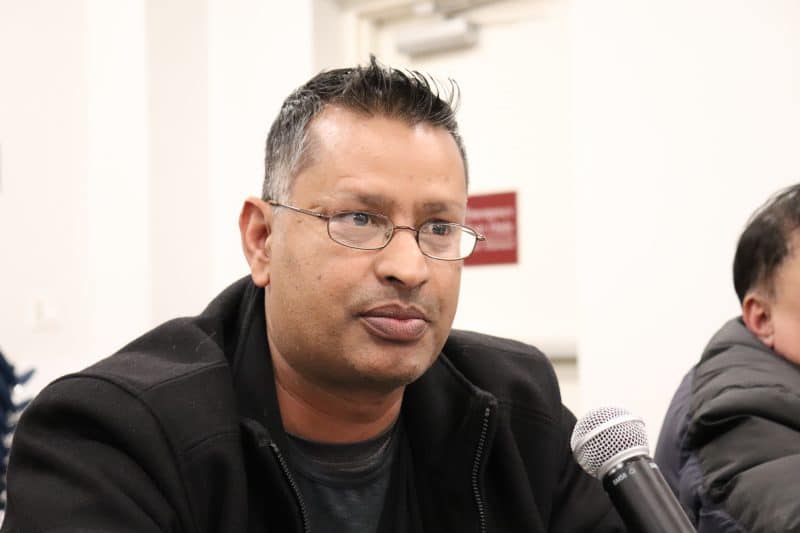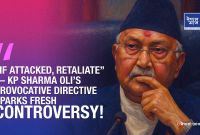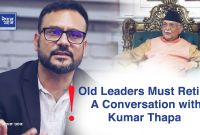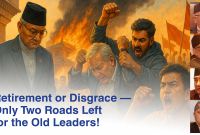Is This the End of KP Oli’s Legacy? One Meeting, Many Questions!
KP Oli’s Illusions and India’s Calculations: Unmasking the Nexus of Nepali Power and Hindutva Ambitions

By Rajesh Mishra
Prime Minister KP Sharma Oli’s heart must be soaring above the clouds these days. After all, Indian Prime Minister Narendra Modi has finally granted him the long-anticipated “meeting” he so desperately desired. But was this 40-minute private encounter held in Bangkok — beyond both Indian and Nepali borders — a result of Foreign Minister Arzu Rana Deuba’s relentless, albeit undignified lobbying? Or did it carry deeper strategic messages cloaked in Indian self-interest? The digital intelligentsia is yet to deliberate fully on this.
One thing, however, is clear: KP Oli’s political demeanor remains unaltered. At over seventy years old, he continues to exhibit a narcissistic and abrasive disposition. On a previous return from the UN General Assembly, when asked by the media about his trip, Oli snapped: “What should I bring back? Was I out to milk a buffalo?” Given the vast sums of public money spent on such foreign delegations, the people were right to expect a serious and accountable response from their executive head. Sadly, Nepal’s mainstream media failed to hold him to account then.
This time, when asked about his delayed visit to India, his answer was no less flippant: “Has barbed wire been installed? I’ll go when I have time.” This habit of making light of serious matters, and the public’s habit of brushing it off, are both symptomatic of a deeper malaise.
From a Meow to a Roar: What Changed for Oli After BIMSTEC?
Oli did not return from the BIMSTEC summit in Bangkok as the man he was when he left. Apart from finally meeting Modi, certain internal developments seem to have reinforced his sense of power.
Oli maneuvered to shield electricity-consuming industrialists who owed large dues to the Nepal Electricity Authority (NEA), by not reappointing NEA’s Executive Director Kulman Ghising — a decision many suspect was to appease the energy minister and big business lobbies. The public outcry that followed could have turned into a mass movement. But the pro-monarchy protest in Tinkune, allegedly orchestrated with the consent of deposed King Gyanendra, turned violent, giving the government an excuse to change the public narrative. Kulman’s dismissal was conveniently buried in the headlines.
Frustrated by poor governance and ineffectual leadership, the public was already on edge. Any spark could ignite unrest. But when the counter-revolutionary aristocrats raised their heads, the discontented populace instinctively rallied around republican values—not in support of the government, but to protect the system from collapse. The three key powerholders of present-day Nepal — Oli, Deuba, and Dahal — have opportunistically benefited from this sentiment. Yet the people are merely lying in wait, watching, biding their time. The joy of these leaders will be short-lived. A photo op with Modi will not quench the fire of growing national discontent.
Geopolitical Theater and Domestic Unrest
Two neighboring states, tied by an open border, choosing to meet in a third country — and expecting it to signal diplomatic success — speaks volumes about the fragility of Nepal’s sovereignty. Since Nepal’s transition into a republic, the triumvirate of Oli, Deuba, and Dahal have governed under the guise of democracy, claiming to defend the system from collapse while serving their own interests. Eighteen years of this charade have left the country cynical and worn.
When political leaders prostitute national emotions in the name of stability and throw themselves prostrate before Indian power centers during official visits, it becomes a matter not only of disgrace but of national threat. This is not merely a concern for royalists — it is a concern for every conscious Nepali. The trio may protect themselves behind the shield of parliamentary arithmetic for now, but this bubble cannot last forever.
Yes, republicans will naturally resist royalist uprisings. But if public frustration intensifies, the ruling trio won’t find the same luxurious protection that the deposed monarch enjoys in Nirmal Niwas. Their happiness, therefore, is fleeting.
The Hindutva Undertones and Modi’s Calculations
It is not surprising that India’s ruling Bharatiya Janata Party (BJP) seeks to stir the embers of Hindu nationalism in Nepal for electoral gain. Uttar Pradesh Chief Minister Yogi Adityanath — head of the Gorakhnath Math and a long-time ideological ally of Nepal’s Shah dynasty — maintains an intimate relationship with deposed King Gyanendra. Adityanath has consistently advocated for a Hindu monarchy in Nepal, although this remains his personal conviction, not official Indian policy.
Modi may find political gain in letting Adityanath drum up Hindu fervor in Nepal. But India’s establishment is not prepared to risk regional stability by reimposing monarchy in Kathmandu. Royalist campaigners in Nepal have already sensed this. A “Hindu Nation” and a “Hindu Empire” are very different ideas. BJP may toy with the former rhetorically, but the latter is off-limits.
India is a mature democratic state with deep institutional memory. Even if Modi rules with a semi-authoritarian majority, India’s foreign policy remains consistent across governments. The illusion that BJP would restore monarchy in Nepal is one the Nepalese royalists must abandon. Gyanendra likely understands this far better than the monarchy’s street-level cheerleaders.
Hypocrisy in Nepali Foreign Policy and the Myth of Alignment
Nepal has cycled through fourteen governments in seventeen years. Its foreign policy is vague, incoherent, and reactionary. Though five prime ministers from Nepal’s communist parties have claimed ideological proximity to China, in practice, all of them have tripped over themselves to become New Delhi’s preferred son.
One must ask: Why did KP Oli and Madhav Nepal push through the Mahakali Treaty at any cost — even splitting their party? And why is that same treaty now languishing? What changed? Why does India hesitate to implement what it once insisted upon?
Why, when Prachanda — once a self-proclaimed anti-India insurgent — wraps himself in saffron robes in Ujjain’s temples, do we not challenge this betrayal of revolutionary ideals? The problem lies not in Delhi, but within us.
The Diplomacy of Arzu Rana Deuba
Nepal’s Foreign Minister Arzu Rana Deuba directly asked her Indian counterpart, S. Jaishankar, whether India was backing the monarchist movement in Nepal. This detail was revealed by former Indian ambassador Ranjit Rae in a podcast interview. Jaishankar, of course, gave no confirmation. Yet upon returning to Nepal, Arzu told reporters, “India is not in favor of regime change in Nepal right now.” For a sitting foreign minister to undermine her own country’s sovereignty in such terms is alarming. But given her position — upheld by the party her husband leads — expecting accountability is a joke.
India seems eager to wash its hands of the violent royalist protests. Rae said, “There is no truth to claims that India wants to see Nepal become a Hindu nation or restore monarchy.” When asked why images of Yogi Adityanath appeared in the protests, Rae replied with a smirk, “Every protester in Nepal curses India by day, and begs for its support by night.”
Nepal’s Internal Crisis and Its Guardians of Disorder
The deposed monarch’s ambitions are no longer hidden. He could have remained a businessman, benefiting from state privileges and avoiding political turmoil. But that was not his path. Oli and Deuba — both currently holding parliamentary weight — have long opposed the very federal system they now pretend to uphold.
KP Oli’s resistance to federalism is a matter of record. Deuba’s rhetoric around “Undivided Far West” gave rise to Rastriya Janata Party leader Resham Chaudhary, and lit the dormant Tharuhat movement. The recent violence in opposition to the Pathibhara cable car project is also not just about a single businessman — it reflects deep identity-based frustrations.
The federal government, meanwhile, is quietly strengthening Chief District Officers (CDOs) and hollowing out provincial authority. Local governments remain beholden to Kathmandu for even basic project approvals. The slogan “Singha Durbar in every village” is now nothing more than a joke.
Oli, Deuba, and Dahal have collectively hijacked the federal constitution. Everything visible is just a stage play. During the recently concluded 61-day winter session of parliament, only nine bills unrelated to federal implementation were passed. None of the essential laws required for federal governance even made it to the floor.
The Boiling Point Approaches
The royalist movement is not the disease — it is a symptom. The pressure cooker is steaming, and the whistle is about to blow. The triumvirate are no longer safe.
And finally, a question for the so-called “second-generation youth leaders” of Nepal’s mainstream political parties:
Will you clutch a dead cat and leap onto the pyre, or will you finally confront your role in this national tragedy?
Whether Congress, UML, or Maoist — their names may differ, but their character is the same. All are infected by the same disease. Do you recognize the symptoms?
If not, recall how Arzu was ushered into parliament under the women’s quota after losing an election — and was made Foreign Minister. Did you protest? Did your revolutionary blood boil when she said that India would decide whether Nepal gets regime change?
Did you challenge the UML when it sold a proportional seat to a businesswoman who was absent for the constitution’s adoption?
The royalist movement is just a warning sign. Your so-called “Shree Tin” — Oli, Deuba, Dahal — are the true epidemic.
Treat them. Before it’s too late.
Editorial Note: This editorial view was written by Rajesh Mishra, Senior Journalist, currently residing in California, USA.
KP Sharma Oli Rajesh Mishra




![From Kathmandu to the World: How Excel Students Are Winning Big [Admission Open]](https://nepalaaja.com/img/70194/medium/excel-college-info-eng-nep-2342.jpg)
